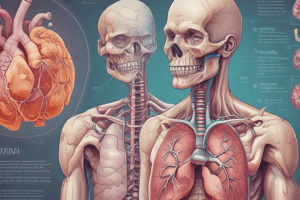Podcast
Questions and Answers
What is the primary characteristic of pneumonia as defined in the provided content?
What is the primary characteristic of pneumonia as defined in the provided content?
- Infection affecting the heart
- Infection that fills air sacs in the lungs with fluid or pus (correct)
- Inflammation of the skin
- A non-infectious pulmonary disorder
Which of the following classifications of pneumonia is associated with the entire lung lobe being affected?
Which of the following classifications of pneumonia is associated with the entire lung lobe being affected?
- Lobar pneumonia (correct)
- Bronchopneumonia
- Interstitial pneumonia
- Aspiration pneumonia
What type of pneumonia develops signs or symptoms after 48 hours of hospital admission?
What type of pneumonia develops signs or symptoms after 48 hours of hospital admission?
- Hospital-acquired pneumonia (correct)
- Community-acquired pneumonia
- Aspiration pneumonia
- Ventilator-associated pneumonia
Which risk factor is NOT associated with community-acquired pneumonia?
Which risk factor is NOT associated with community-acquired pneumonia?
Which of the following is a typical bacterium identified in community-acquired pneumonia (CAP) cases?
Which of the following is a typical bacterium identified in community-acquired pneumonia (CAP) cases?
How does aspiration pneumonia occur?
How does aspiration pneumonia occur?
What defines ventilator-associated pneumonia?
What defines ventilator-associated pneumonia?
Which atypical microorganism is recognized as a cause of community-acquired pneumonia?
Which atypical microorganism is recognized as a cause of community-acquired pneumonia?
What percentage of community-acquired pneumonia (CAP) cases are considered polymicrobial?
What percentage of community-acquired pneumonia (CAP) cases are considered polymicrobial?
Which of the following bacteria is associated with complicating influenza viral infections?
Which of the following bacteria is associated with complicating influenza viral infections?
Flashcards are hidden until you start studying
Study Notes
Pneumonia Definition
- Pneumonia is an infection affecting one or both lungs
- The infection causes the air sacs (alveoli) of the lungs to fill with fluid or pus
Pneumonia Classifications
- Pneumonia is classified by site of infection, the type of organism causing it, and whether it's acquired in the community or a healthcare setting
- Anatomy/Histology:
- Lobar Pneumonia: Affects a single lobe of the lung
- Bronchopneumonia: Affects patchy areas of multiple lobes and bronchioles
- Interstitial Pneumonia: Affects the interstitium, the space between the lung tissue
- Etiology (Cause):
- Bacterial: Including Streptococcus pneumoniae, Haemophilus influenzae, Staphylococcus aureus, Klebsiella pneumoniae, and Pseudomonas aeruginosa
- Viral: Including influenza, rhinovirus, and respiratory syncytial virus (RSV)
- Fungal: Less common
- Atypical: Caused by microorganisms like Mycoplasma pneumoniae, Chlamydophila pneumoniae, and Legionella
- Parasitic: Rare
- Aspiration: Caused by inhaling food or vomit into the lungs
- Location of Acquisition:
- Community-acquired pneumonia (CAP): Develops outside of a healthcare setting
- Hospital-acquired pneumonia (HAP): Develops at least 48 hours after hospital admission
- Ventilator-associated pneumonia (VAP): Develops within 48 hours of intubation or in the 48 hours after extubation
- Aspiration pneumonia: Occurs due to inhaling food or vomit into the lungs, often seen in patients with difficulty swallowing
Community-Acquired Pneumonia (CAP)
- Leading cause of death from infectious diseases
- Only 38% of CAP cases have identified pathogens
- Risk factors:
- Smoking
- Alcohol consumption
- Larger household size
- Pre-existing conditions (comorbidities)
- Age (as cough and gag reflex can weaken)
- Etiology:
- Typical bacteria: Streptococcus pneumoniae, Haemophilus influenzae, Staphylococcus aureus, Klebsiella pneumoniae, Pseudomona aeruginosa
- Atypical microorganisms: Mycoplasma pneumoniae, Chlamydophila pneumoniae, Legionella species
- Respiratory viruses: Influenza A and B, rhinovirus, human metapneumovirus, respiratory syncytial virus (RSV), parainfluenza, severe acute respiratory syndrome coronavirus-2 (SARS-CoV-2), adenovirus
- Polymicrobial: 10-15% of CAP cases are caused by multiple microorganisms
- Staphylococcus aureus pneumonia: Is often associated with influenza virus infection
Studying That Suits You
Use AI to generate personalized quizzes and flashcards to suit your learning preferences.




